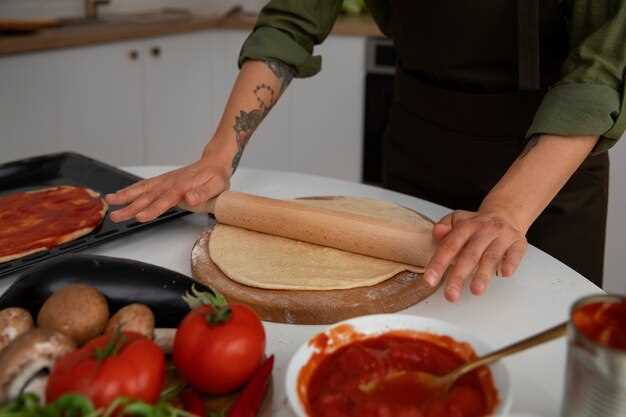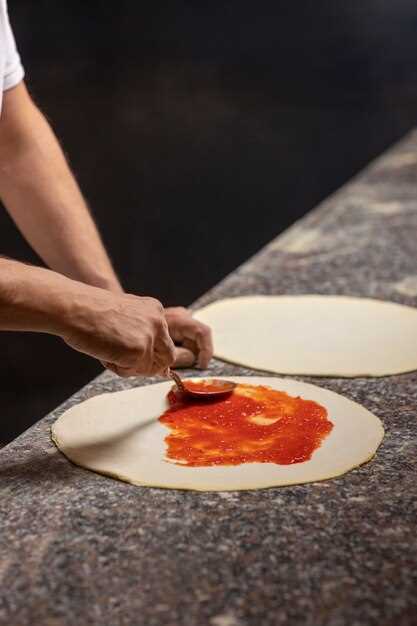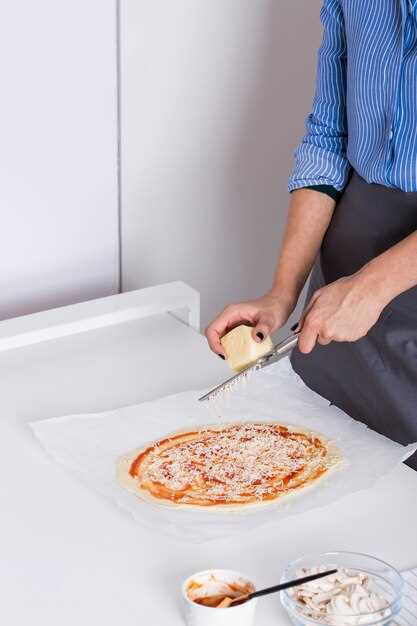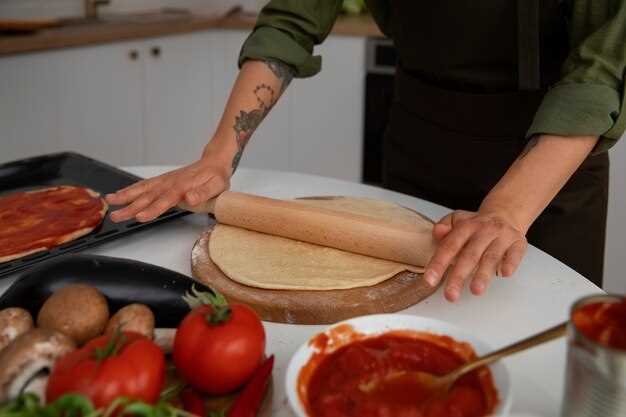Start with high-quality ingredients to ensure the best results. Opt for 00 flour, known for its finely ground texture, which yields a soft yet crisp crust. Using a high-quality olive oil not only enhances the dough’s flavor but also contributes to moisture retention during baking, resulting in a tender base.
Focus on achieving the perfect dough. Mix your flour with yeast, salt, and water, ensuring the right balance to develop gluten. Knead the dough thoroughly until smooth and elastic. Allow it to rise in a warm environment until it doubles in size. This step is critical for developing flavor and texture, so be patient.
For the sauce, use canned San Marzano tomatoes for their balance of sweetness and acidity. Blend with garlic, oregano, and basil for a savory, aromatic base. Spread the sauce thinly over the rolled-out dough to maintain a good crust-to-sauce ratio.
Cheese selection makes a significant difference. Use fresh mozzarella for a creamy consistency and pair it with a sprinkling of parmesan for depth of flavor. For additional topping ideas, consider using thinly sliced vegetables or cured meats. Balance the toppings to avoid overwhelming the crust.
The baking process is integral for texture and flavor. Preheat your oven to the highest temperature, ensuring it simulates a pizza oven. Use a preheated pizza stone or a baking sheet to transfer the pizza, allowing for a crispy base. Bake until the edges are golden and the cheese is bubbling.
With these tips, you’re well-equipped to craft a pizza that rivals your favorite pizzeria. Each carefully chosen ingredient and step in the process contributes significantly to your homemade pizza’s excellence.
Mastering the Pizza Dough

Use high-protein flour for the perfect balance of chewiness and crisp crust. Opt for “00” flour or bread flour if possible. Hydrate the dough with water at a ratio of 60-65%. This hydration level is optimal for home baking environments.
- Mix the ingredients: Combine flour, water, yeast, and salt in a large bowl. Stir until a shaggy dough forms.
- Knead the dough: Transfer it to a floured surface and knead for 8-10 minutes. The dough should become smooth and elastic.
- Control fermentation: Let the dough rise in a greased bowl, covered with a damp cloth, for 1-2 hours at room temperature. For enhanced flavor, refrigerate the dough for 12-24 hours.
- Temperature management: Allow refrigerated dough to rest at room temperature for an additional hour before shaping.
Divide and shape the dough gently into balls without deflating it too much. Rest the dough balls for 30 minutes before stretching them into pizza bases. A well-mastered dough becomes the heart of a delightful homemade pizza. Experiment with different hydration levels and resting times to achieve the desired crust texture.
Choosing the Right Flour for Your Dough
Opt for bread flour if you crave a chewy, airy crust with well-defined bubbles. Its higher protein content, around 12-14%, creates strong gluten networks, perfect for achieving that quintessential texture. However, all-purpose flour remains an excellent choice for softer, more tender doughs, offering a balance at 9-12% protein.
For those seeking an authentic Neapolitan style, Caputo ‘00’ flour stands out with its finely ground particles and elasticity-enhancing qualities. While it boasts a moderate protein content of around 11-12%, its unique milling process delivers a silky, smooth dough.
Explore alternative grains like whole wheat for added depth in flavor and a nutritional boost. Expect a denser bite and a hearty, robust crust, as whole wheat contains more bran, impacting gluten development.
Here’s a quick comparison to help choose the right flour for your homemade pizza:
| Type of Flour | Protein Content | Texture |
|---|---|---|
| Bread Flour | 12-14% | Chewy, Airy |
| All-Purpose Flour | 9-12% | Softer, Tender |
| Caputo ‘00’ Flour | 11-12% | Silky, Smooth |
| Whole Wheat Flour | Approx. 14% | Dense, Robust |
Tailor your flour choice to suit your desired texture and flavor profile. Enjoy experimenting to perfect your dough!
Kneading Techniques for Optimal Texture
Use the stretch and fold method to enhance the dough’s elasticity. Gently stretch the dough outward on a floured surface, then fold it back toward the center. Repeat this process for about 10 minutes. This technique develops the gluten structure, leading to a chewy crust.
Apply slight pressure with the heels of your hands when kneading. Too much force can overwork the dough, making it tight. A gentle yet firm approach ensures a balanced gluten network, crucial for soft yet firm texture.
Allow the dough to rest intermittently. After each 3-4 minutes of kneading, let it sit for a minute. This rest period helps the gluten relax, making the dough more pliable and easier to handle.
Control the amount of flour used during kneading. Just enough to prevent sticking is ideal. Excess flour can dry out the dough, leading to a dense crust. If the dough becomes sticky, let it rest for a minute instead of adding additional flour.
Observe the dough’s texture and consistency. Once it feels smooth and elastic, it’s ready for resting and rising. Ensure the dough can be stretched thinly without tearing, a sign of optimal gluten development.
Understanding the Role of Dough Fermentation
Choose a prolonged fermentation process to enhance your pizza dough’s texture and flavor. Allow the dough to rest at least 24 hours in the refrigerator. This extended fermentation promotes the development of complex flavors and improves the dough’s structure.
- Temperature Control: Maintain a consistent, cool temperature during fermentation to slow down yeast activity. This allows more nuanced flavors and a better rise, preventing an overly yeasty taste.
- Hydration Level: Opt for a higher hydration ratio (around 65-70%) to ensure a crispy crust. This will also aid in gluten development, making the dough more elastic.
- Yeast Types: Use active dry yeast or fresh yeast for better fermentation results. Instant yeast can be used for quicker processes, but may not yield the same depth of flavor.
- Timing: A 24 to 48-hour fermentation period is ideal. This timing develops sufficient acidity and flavor without compromising elasticity.
- Mixing Method: Knead the dough initially to combine ingredients, but rely on time and stretch-and-fold techniques rather than overmixing. This prevents dough from becoming too chewy.
- Aromas: Balance fermentation time to achieve desired aromas. Over-fermentation might lead to an overpowering sourness, while under-fermentation can yield a bland taste.
Adhering to these guidelines ensures a perfect balance of flavor and texture, making your homemade pizza a true delight.
How to Shape Your Dough Like a Pro
Begin with a rested dough at room temperature. This makes it easier to stretch and less likely to spring back. Dust your work surface and hands with flour to prevent sticking, but don’t overdo it as too much flour can make the dough stiff.
Flatten the dough gently into a disk using your fingertips. If the dough starts resisting, let it rest for a few minutes. Hold the dough up by the edges, letting it stretch naturally with gravity. Turn it slowly as you do this for an even shape.
For a classic pizza, use the knuckles of both hands. Place your fists under the dough, gently stretching from the center outwards. Focus on keeping the edges slightly thicker to form a good crust.
Work quickly yet carefully. If holes form, pinch the dough together to seal them. Once shaped, move the dough onto a prepared baking sheet or peel covered in cornmeal to avoid sticking during the transfer to the oven.
Assembling and Baking the Pizza

Roll out your pizza dough on a lightly floured surface until it reaches your desired thickness. Transfer the rolled dough onto a pizza stone or a baking sheet lined with parchment paper for easy handling. Spread a thin layer of tomato sauce evenly over the surface, leaving about half an inch along the edges for a crisp crust. Be generous with your selected cheese, spreading it evenly across the sauce. For even melting, use a mix of mozzarella and a hard cheese like Parmesan.
Layer your chosen toppings evenly across the cheese, ensuring not to overload the pizza, which can cause a soggy crust. Popular options include pepperoni, bell peppers, mushrooms, and onions. If adding leafy greens like spinach, consider placing them under the cheese to prevent charring.
Preheat your oven to 475°F (245°C), ensuring it’s thoroughly heated to cook the pizza evenly. Once at temperature, place the pizza stone or baking sheet on the center rack. Bake for about 12-15 minutes, or until the crust turns golden and crispy, and the cheese bubbles and browns slightly. Check regularly to avoid overcooking.
Remove the pizza from the oven and let it cool on a wire rack for a few minutes to allow the cheese to set. Slice with a sharp pizza cutter and serve immediately for the best experience. Enjoy your homemade creation!
Selecting the Best Sauce and Toppings
Choose a high-quality tomato sauce as the base for your pizza. Opt for a sauce that features ripe San Marzano tomatoes, finely crushed to maintain a smooth texture. Enhance flavor with a pinch of sea salt, a dash of freshly ground black pepper, and a hint of dried oregano. To add a layer of depth, mix in a tablespoon of extra virgin olive oil.
When it comes to toppings, balance is key. Select a combination of fresh ingredients for a harmonious flavor profile. Start with fresh mozzarella, torn into small pieces for even coverage. Introduce sliced bell peppers and red onions to add sweetness and crunch. Sprinkle a few olives for a touch of brininess and contrast.
If you’re craving protein, consider adding classic pepperoni or opt for slices of cooked Italian sausage to infuse spice. For a vegetarian twist, include wild mushrooms and spinach, which lend earthiness and vibrant color.
Finish by garnishing with fresh basil leaves post-baking to preserve their aromatic quality. Lastly, remember that less is more; overcrowding will hinder even cooking and flavor integration. Tailor these selections to suit your taste, and enjoy every bite!
Cheese Blending Tips for Maximum Flavor
Combine mozzarella with a sharper cheese like aged cheddar to enhance the overall taste. Mozzarella provides that classic stretch and creaminess, while cheddar injects a more complex, tangy note.
Play with the moisture levels by mixing soft cheeses like fontina with firmer ones such as parmesan. Fontina adds a rich buttery flavor while parmesan contributes its savory, umami profile, resulting in a balanced blend with both smoothness and depth.
Consider the flavor profile of your pizza toppings. If you’re using earthy mushrooms or vibrant vegetables, add a hint of tangy goat cheese to complement those ingredients. Its acidity will cut through the richness, providing a refreshing contrast.
Experiment with a mix of smoked gouda and provolone for pizzas topped with meats. Smoked gouda adds a subtle smokiness, enhancing the flavors of the meats, while provolone offers a mild creaminess that ties it all together.
| Cheese | Texture | Flavor Note |
|---|---|---|
| Mozzarella | Soft | Creamy, Mild |
| Aged Cheddar | Firm | Tangy, Sharp |
| Fontina | Soft | Buttery, Rich |
| Parmesan | Firm | Umami, Savory |
| Goat Cheese | Soft | Tangy, Acidic |
| Smoked Gouda | Semi-Firm | Smoky, Mild |
| Provolone | Semi-Soft | Creamy, Mild |
Optimizing Your Oven for Ideal Baking
Preheat your oven to achieve a crisp crust and evenly cooked toppings; 475°F (246°C) is ideal for most home ovens. Use a pizza stone or steel to mimic the effect of a traditional pizza oven, as these materials retain heat and provide a solid surface. Place it in the oven while it preheats to ensure maximum efficiency.
Position the oven rack in the center to distribute heat evenly. For a more intense bottom heat, move the rack down a level. Avoid using a baking sheet as it may inhibit heat transfer, resulting in a less crispy crust.
Invest in an oven thermometer to verify the accuracy of your oven’s temperature settings. Many ovens deviate from their set temperatures, and inaccurate readings can lead to under- or over-cooked pizzas.
Switch to convection mode if available, as the circulating air can enhance heat distribution and reduce cooking time. Maintain the oven door closed during baking to prevent heat loss and ensure consistent temperature throughout the process.
By following these guidelines, your homemade pizzas will bake to perfection, with a beautifully browned crust and fully melted, bubbly cheese.
The Perfect Bake: Achieving the Desired Crust
Use a pizza stone to replicate the intense heat of a professional oven at home. Preheat the stone in your oven at the highest setting for at least 30 minutes before placing the pizza on it. This ensures a crispy base that supports the toppings.
- Select the right flour: Opt for high-gluten flour to attain elasticity and chewiness, crucial for that perfect crust. Bread flour works wonderfully due to its higher protein content.
- Implement a cold fermentation process: Allow your dough to ferment in the refrigerator for 24–48 hours. This develops complex flavors and improves texture.
- Hydration level matters: Aim for a dough hydration level between 65-70%, balancing moisture to achieve a light and airy crust.
- Kneading technique is key: Knead the dough until smooth and elastic, which will create the ideal gluten structure. This can usually be achieved in about 8-10 minutes of kneading by hand or 5-7 minutes with a stand mixer.
- Master the stretch and fold method: Once kneaded, perform stretch and folds during the initial rise. This strengthens the dough, contributing to a well-structured crust.
- Baking temperature and duration: Bake your pizza at 475°F (245°C) for 10-12 minutes. Monitor closely to ensure the crust achieves a golden brown hue without overcooking.
By focusing on these specific strategies, you’ll consistently bake pizzas with a crust that captures the perfect balance of crispiness and flavor.
Video:

How to Make NEAPOLITAN PIZZA DOUGH like a World Best Pizza Chef
How to Make NEAPOLITAN PIZZA DOUGH like a World Best Pizza Chef
Q&A:
Can I use whole wheat flour for pizza dough instead of all-purpose flour?
Yes, you can definitely use whole wheat flour. It will give your dough a nuttier flavor and a slightly denser texture. You might want to try a mix of whole wheat and all-purpose flour to balance the texture and taste. Start by replacing a portion, such as a third or half, of all-purpose flour with whole wheat and adjust according to your preference.
How do I prevent my homemade pizza dough from becoming too soggy?
A soggy pizza can be avoided by ensuring that your oven is sufficiently hot, ideally around 475-500°F (245-260°C). Using a pizza stone or a preheated baking sheet can help as it absorbs excess moisture and distributes heat more evenly. Additionally, be mindful of the toppings; use them sparingly, and opt for low-moisture cheese. Precooking vegetables with a high water content, like mushrooms or bell peppers, can also help reduce moisture.
What type of sauce is best for homemade pizza?
The choice of sauce can significantly impact the flavor of your pizza. A classic tomato-based sauce is a popular and versatile choice. It typically includes pureed tomatoes, garlic, olive oil, and herbs like basil and oregano. If you’re feeling adventurous, you can try alternatives like pesto, white sauce (béchamel), or even barbecue sauce, depending on the toppings and the flavor profile you desire.
How long should you let the pizza dough rise?
The rising time for pizza dough can vary based on the recipe and environmental conditions. Generally, allowing the dough to rise for at least 1-2 hours at room temperature is common. For improved flavor and texture, many recommend refrigerating the dough overnight or up to 24 hours. This slower fermentation allows for deeper complex flavors and a more airy crust.
Do I need any special equipment to make a great homemade pizza?
While no special equipment is absolutely necessary, having a few tools can enhance the pizza-making experience. A pizza stone or steel helps create a crispy crust due to its excellent heat retention. A pizza peel makes transferring the pizza to and from the oven easier. Additionally, a dough scraper can be useful for handling and dividing the dough. These tools, while not essential, can improve your process and results.
Why does my homemade pizza crust end up too soggy, and how can I fix it?
A soggy pizza crust is a common issue that can be caused by several factors. One significant reason might be the type and amount of toppings used. Too much moisture from toppings, like vegetables, can release water during baking, making the crust soggy. To counter this, try sautéing vegetables to remove water before adding them to the pizza. Another reason could be the oven temperature. For a crispy crust, bake your pizza at a higher temperature, around 475°F (245°C), ensuring that it cooks quickly without allowing moisture to seep into the dough. Also, consider using a pizza stone or steel, which helps absorb moisture and promotes even cooking.
What type of flour is best for making homemade pizza dough, and what are the differences between them?
Choosing the right flour is key to achieving the desired texture in your pizza dough. All-purpose flour is commonly used and works well for a basic pizza dough, resulting in a softer crust. However, for a chewier, more elastic dough, consider using bread flour, which contains more gluten. Gluten provides the dough with the strength and elasticity needed for a robust crust that can withstand handling and toppings. Alternatively, for a traditional Neapolitan-style pizza, you might want to use 00 flour, which has a fine texture and creates a tender, yet crisp crust. Each type of flour brings subtle differences in taste and texture, allowing you to customize your pizza to your liking.
